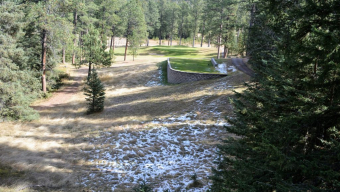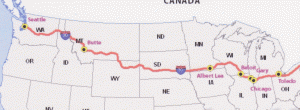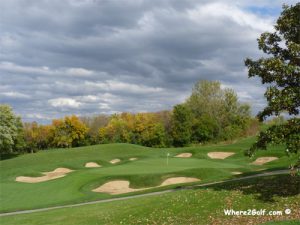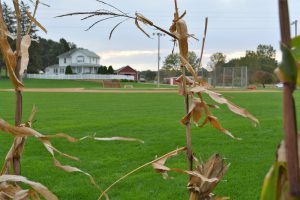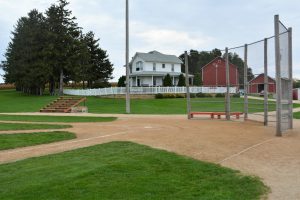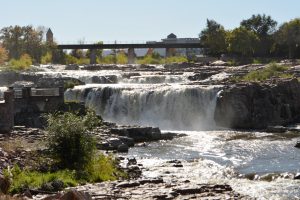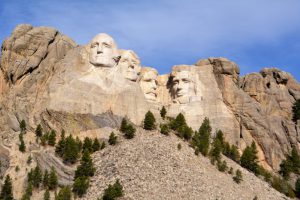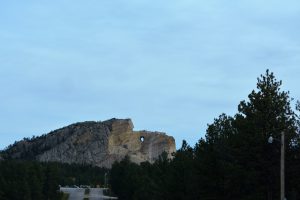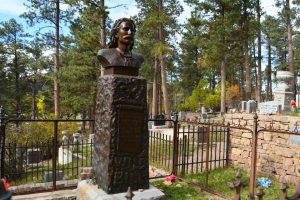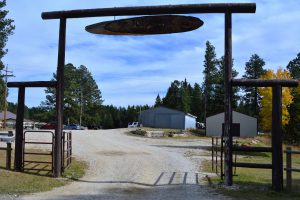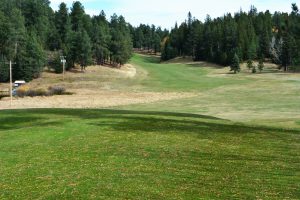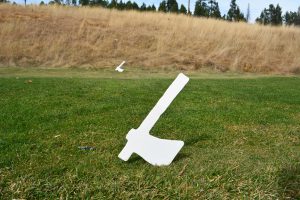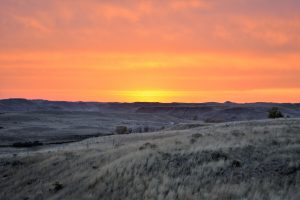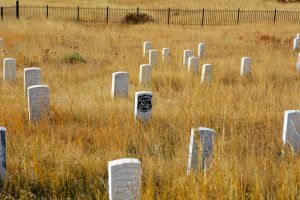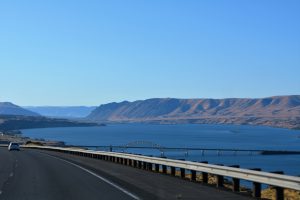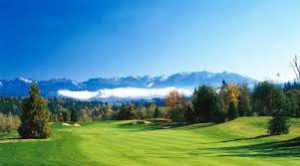(Editor’s note: During a recent Cleveland-to-Seattle road trip roughly following along I-90, I took the time to sight-see and play some golf. Here is a travel log of that five-day sojourn with suggestions on what to see and where to play a string of Hidden Gems).
ALONG I-90, USA — From sea-to-sea, legendary Interstate 90 is the travel spine of America. It begins near Fenway Park and Ted Williams Tunnel in Boston and ends at Edgar Martinez Way at Safeco Field in Seattle. It covers 3,020 miles, longest road in the nation, and without even one traffic light.
The long expanse was established in the 1950s under President Eisenhower’s national highway system initiative. It strung together a series of already established roads for what is now an unimpeded pathway west. I picked up my late father-in-law’s Ford F-150 pickup in Cleveland and drove it back to Seattle. It’s hard to imagine a more comfortable, roomier and safer vehicle than this higher-profile, heavy-duty ride, promising an average of 18 miles on the highway, 14 in the city.
Before the journey began, the preferred place to play golf in the Cleveland area is one of the great hidden gems in the country, Canterbury Country Club in suburban Beachwood. It’s a classic-style course designed by Englishman Herbert Strong and opened in 1922.
It has hosted five Majors – two U.S. Opens, the PGA and two U.S. Amateurs – and overall 13 significant championships. Its winners are legends, Jack Nicklaus (1973 PGA), Walter Hagen (1932 Western Open), Lawson Little (1940 U.S. Open), Lloyd Mangrum (1946 U.S. Open), Mark O’Meara (1979 U.S. Am), Arnold Palmer (1984-85 Senior TPC) and Chi Chi Rodriguez (1986 Senior TPC).
With refinements in equipment technology, the PGA Tour professionals eventually out-drove the 6,942-yard Canterbury circuit, although it’s still ideal for senior events, hosting both the U.S. Senior Open and U.S. Senior PGA. The strength of the course is not length but the complexities of the greens. As Sam Snead once said that he’d “much rather face a rattlesnake than a two-footer at Canterbury.”
The holes meander in all directions throughout, as no one hole is like another and none is exactly parallel to another. The signature hole is probably the par-4, 384-yard 15th. Your approach shot, probably blind, is up a 30-foot bluff to an elevated green set well back into the hill.
It’s wonderfully maintained with a venerable clubhouse. Many of the game’s major trophies are in a case in the middle of the clubhouse as is as Henry Picard’s Green Jacket. Picard won the 1938 Masters and became the club’s head professional beginning in the 1940s. He steered the course towards its championship destiny.
Picard famously once gave a swing tip to Ben Hogan that even Hogan credits to have changed his career for the better.
The clubhouse recently underwent a remodel, adding a wonderfully masculine lower-level private bar that is the ideal hideaway in this hidden gem.
Cleveland has taken a bad rap for decades but, as someone who grew up there, it’s moving from dark to light. Its once aging and neglected downtown is beginning to blossom with new condos and apartments, nationally regarded restaurants and chefs and a great entertainment center in the industrial Flats.
The West Side Market, on the near west side just north of I-90, is a wonder. Fresh ethnic foods, jammed restaurants and a beehive of activity. Not far from the market is The Christmas Story house, on West 11th St. Worth a side trip for those who loved that classic 1983 movie.
Your I-90 trip west from Cleveland should begin just south of Progressive Field, one of the top five baseball stadiums in the country with its distinctive toothbrush style light towers. From there, it’s due west, toward Toledo, Gary, Ind. and Chicago.
This also begins a series of toll roads, from western Ohio, all of Indiana and much of Illinois. All tolled, you’ll have to pay more than $20 at various I-90 booths as each municipality wants its pound of tourist flesh. After Illinois, all the way to Seattle, there are no tolls collected.
Indiana is mostly nondescript, although a quick side trip suggestion would be South Bend, home of the University of Notre Dame, not far from I-90. Cool buildings and a vibrant campus, especially in the fall when I drove through as the folks are tingling over their high-ranked football team. Get there early in the day to wake up the echoes.
I-90 then swings through the workingman’s town of Gary followed by big-shoulder Chicago. Drove through Chicago, past Addison St., where Wrigley Field, the country’s second oldest big-league park, is located. On this bright sunny afternoon as I drove past Addison, the Cubs were playing Washington in the first round of the baseball playoffs, the traditional October competition that I followed on the radio during the drive and watched each evening.
One suggestion for golf in the area would be a course I played in the past, Cog Hill Golf and Country Club in Lemont, Ill., about 15 miles slightly southwest of Chicago. It was built – by the Coghill Brothers – and opened around the same time as Canterbury in the 1920s. There are actually four courses on the site, with the No. 4 Dubsdread course as the premier layout.
What I remember most about Cog Hill was bunkers galore. There was one hole that had the green surrounded. Another had a series of traps from about 100 yards out, like a ladder leading to the green. I darted in and out of at least three of them.
From Chicago, I-90 diverts from its mostly westerly flow to mostly north toward Wisconsin. I actually switched (by accident) to I-94, which is straight north, parallel and not far from Lake Michigan, directly toward Milwaukee. I-94 eventually merges back with I-90 just east of Madison, Wis. That was too far north for my purposes and destinations, so, just over the Wisconsin border, it was a better and more scenic ride to take two-lane back roads due west.
This route is so much better because the quaint small towns and lush farming countryside, not readily seen from I-90. One of the most scenic villages you can find in America is Lake Geneva, Wis., with great parks, swimmers and boaters in abundance and large turn-of-the-century mansions along the lake, originally built by wealthy Chicagoans who vacationed there.
Just out of town along state route 50, you’ll come across the entrance to Geneva National Resort and Golf Club. Didn’t have time to play golf, since I was on schedule, but it looks inviting. There are three courses, the Arnold Palmer, the Gary Player and the Lee Trevino. Big time names who were involved in the designs.
Palmer once said that the 17th hole on his namesake course is one of his favorite holes in the country. It’s a par-5, 573-yard hole tight against Lake Como all along the left side. All three courses weave in and out of thick Wisconsin forests.
When you have time, this is a good choice in addition to plenty of other hidden gems north and south of I-90. However, at that point I was focused on getting miles behind me. It was slower in the dark along the farming-country back roads, avoiding deer and other creatures crossing the undulating roads but worth the adventure.
My first overnight was at the historic city of Dubuque, Iowa, just over the Mississippi River. It’s named after French trapper Julien Dubuque, who arrived in the city in 1785. Stayed at the 102-year-old Hotel Julien (named after him), just off the freeway in the middle of the city. The original hotel on the site once had Abraham Lincoln, Wild Bill Cody and Mark Twain as guests. In the 1930s, Al Capone fled to the hotel with his posse to escape law enforcement heat in Chicago.
One of the reasons for making time, putting off golf and staying south of I-90 was so I could be ready in the morning for one of the drive’s highlights – the Field of Dreams movie site in Dyersville, Iowa. It’s about a 20-mile ride west from Dubuque on state route 20, deep into the rich, rolling corn-and-soy fields of northeast Iowa.
For many, mostly men, Field of Dreams is one of the favorite movies of all-time, with its father-son baseball theme and its vestiges of what the game means to America. Drove into the Dyersville site at least a half hour (couldn’t wait) before it opened. There’s no gate or people to stop you from easing into the parking lot.
It’s everything you had hoped it would be, the well-used ball field, the outfield cornfield (high and brown stalks), the distinctive country house on the hill and the simple bleachers where many of the scenes were filmed. A caretaker, mowing the lawn, said I could venture anywhere I wanted. So, what any visitor must do, I headed out to the left-field cornfield to see if I would disappear.
The 1989 movie used this Lansing Family farm site as its iconic backdrop. A group of investors purchased the property about five years ago, setting up a souvenir stand in the parking lot and fencing off the house. Daily house tours are conducted but it’s free to just roam around. The field is used all the time by Little League and softball teams. It can be rented out at night for tournaments. They will come, and are still coming.
The rest of the day was filled with wonderful small towns in northern Iowa and southern Minnesota, following a series of country roads on the way back to I-90. Exited Iowa through Mason City, on the way to Albert Lea, Minn., where I resumed I-90.
Thought of playing a round at Hazeltine National Golf Club in Chaska, Minn., one of only two clubs to host every major USGA championship, including the Ryder Cup (2016), U.S. Open (1970, ’91) and PGA (2002, ’09). Decided against it because it would have been a long drive north, about 50 miles to Minneapolis area, and heard that it may not live up to its lofty status.
So the mission then was to just drive as far as I could, another two/thirds through Minnesota and virtually all of South Dakota, probably 600 miles. Stopped at Sioux Falls in southeastern SD to see the falls and get a bite. Worth it. Then across the gorgeous Great Plains to Rapid City, SD., setting up in a modest hotel to watch the baseball playoffs.
Rapid City is the optimum place to stay, lots of available fair-priced hotels, indoor water parks for families and a perfect stopping-off point for my subsequent day of spectacular tourist experiences. One-by-one, you just pick them off within easy driving range.
Get up early and take state route 16 south, through the rugged, rocky Black Hills to Rushmore National Monument and watch the morning sun shine George, Tom, Teddy and Abe. It’s a jarring sight as you rise up and round a corner to see four familiar stone faces peering at down at you. I took binoculars with me and that bought the four closer so you could see all the etchings and imperfections on their faces. It’s something everyone in the country should see, a first for me.
You then continue on the same road to Crazy Horse Monument, which dwarfs Rushmore. The mountain side carving of the great Oglala Sioux warrior began in 1948 and it still has a long ways to completion. You can see his profile but the rest of the arm and torso need to chiseled through. It costs $20 at the gate to see it but everything is right there as you enter the complex. For me, it wasn’t worth the expense so I came, I paused, I saw and I U-turned, heading back through the wondrous Black Hills toward Deadwood.
Deadwood. Wild Bill Hickok. Calamity Jane. Potato Creek Johnny. Poker Alice Tubbs. Colorado Charlie Utter. Seth Bullock. Jack McCall. Dead Man’s Hand.
This is the quintessential western town, full of lore, legend and more than a few cheaters and liars. It’s about 30 miles northwest of Rapid City and 15 miles west of Sturgis, the Harley-Davidson mecca. Deadwood is deep into a series of Black Hills valleys, but you have to pass through hotels/restaurants strips leading to the frontier town, in which many original buildings are still standing.
Among the buildings still around is Nuttal & Mann’s Saloon. That’s where, on Aug. 2, 1876, plotter Jack McCall sneaked in and shot Hickok in the back of the head. Hickok’s poker hand showed aces & eight, forever known as “Dead Man’s Hand.”
Hickok, who made his gun-slinging reputation elsewhere, was in Deadwood for only three weeks, yet he’s remains the biggest legend. He is buried in a prominent plot in Mount Moriah Cemetery above the town. Calamity Jane, who was in love with Hickok and wanted to be buried next to Hickok (he didn’t care), is, indeed, alongside him.
In just a two-hour trial for McCall, he was found not guilty. He quickly departed but couldn’t stop boasting about the murder. He was finally retried in a real courtroom, was found guilty and hanged less than a year later.
Amid this western backdrop, I noticed that there was a golf course, Tomahawk Country Club about five miles out of town on Highway 385. Just the juxtaposition of the two elements, a no-holds-barred lawless town vis-a-vie the self-regulated gentleman’s game was enough to compel me to play here.
Tomahawk is a nine-hole course designed by Lawrence Hughes, the architect behind more than 20 mostly West Coast courses. Others include, La Quinta, Eldorado, Indio, Marin, Paradise Valley and Santa Barbara.
Opened in 1933, Tomahawk basically weaves full circle around a modest pine-topped mountain in the middle of the Black Hills National Forest.
It was pleasant short-sleeved weather but snow was scattered about from a storm two days earlier. The first hole, a par-5, 541-yarder, is wide open for your drive. But the approach to a slopey green is squeezed by trees.
The second hole is quirky. From the green it looks like a dogleg left but it’s actually a severe dogleg right, over a bulbous hill. You’ll have a short (inside 150 yards) but likely blind approach to an elevated green.
Perhaps the best hole of the nine is the par-3, 179-yard third hole, elevated tee to small elevated green. You’ll need a long, accurate and lofty drive to hit and stay on the green.
From there, the course begins its turn around the central mountain. It’s raw country, with moose, elk and bear scat in abundance. Watch your step.
Between holes five and six, there is a long path through the pines on the edge of the property. It’s a refreshing ride that serves as a fresh-air respite.
For each of the final four holes, 6 through 9, you have to deal with the meandering Bear Butte Creek at various distances. For the par-5, 540-yard seventh, the course’s toughest hole, Bear Creek weaves through to affect your drive and then your second shot.
There is not enough room to build another nine holes but there is virtue in nine-hole courses. You can return to the same layout, perhaps shifting to a different tee, and replay your best shots and try to correct your bad ones.
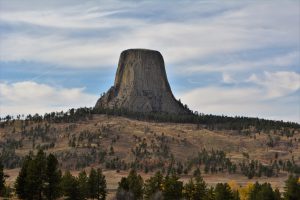
Stunning Devils Tower in southeastern Wyoming
The day, packed with tourist shines and even a round of golf, was not over. Within a relatively short drive into northwestern Wyoming, standing it the middle of a vast open space is the peculiar Devils Tower. It looks like a giant tree stump, with its flat top and bark-like lines down its side. You might remember it as the centerpiece of the 1977 movie ‘Close Encounters of the Third Kind.’ It is the most unusual mountain you can find in the world.
The fourth day of the trip began before sunrise in
Wyoming. Had the motivation to see one more compelling attraction – the Little Bighorn Battlefield – and getting through the incredibly long state of Montana (551 miles) and into Idaho.
Little Bighorn is near Hardin, Mt., in the southeast corner of Montana, a region where the General George Custer used to raid Native American camps with the Seventh Calvary. Custer, under the order of President Grant, had the responsibility to protect settlers, pioneers, gold miners and wagon trains through hostile Indian territory and needed to engage the tribes and herd them into reservations.
There were atrocities committed on both sides leading up to the culminating ‘Last Stand’ confrontation. Crazy Horse, a Oglala Sioux warrior, managed to pull together various disparate tribes into one large desperate force against the U.S. soldiers. It all reached a crescendo on June 26, 1876 on a slope near Little Bighorn creek.
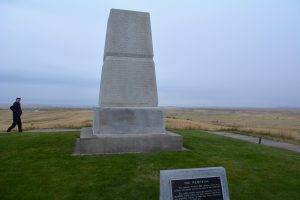
Memorial at Little Bighorn battlefield where the bodies of the fallen soldiers were collected and buried
There was much confusion and miscommunications during the various battles but in the end Custer’s men finally found themselves outflanked by two separate and overwhelming Indian warrior forces. They were slaughtered to the last man. Marble plagues throughout the battlefield indicate where each man fell, including a black-marked stone for Custer. The site is less than two miles off I-90.
Then the vast and spectacular ‘Big Sky’ of Montana was my companion for the next six hours. The speed limit in the state is 80 but is essentially there is no limit. You just click off the widely-spaced cities, Billings, Bozeman, Butte, Missoula. Over the final 50 miles in Montana and virtually all of the Idaho panhandle the road becomes wonderfully mountainous. You wouldn’t want to travel through much later than when I did, as the snow was falling through the Idaho passes.
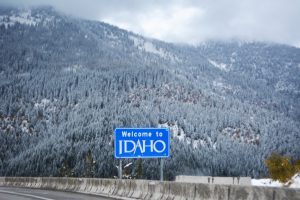 The mountain road finally descends into eastern Idaho at Coeur d’Alene, most famously known as the home of the “Island Green.” The Coeur d’Alene Golf Course is a resort course connected to the elegant hotel. It’s always in fabulous shape, has some captivating par-3s and a pleasure to play. But the dominant feature is the par-3, 14th hole, one of the more famous holes in America.
The mountain road finally descends into eastern Idaho at Coeur d’Alene, most famously known as the home of the “Island Green.” The Coeur d’Alene Golf Course is a resort course connected to the elegant hotel. It’s always in fabulous shape, has some captivating par-3s and a pleasure to play. But the dominant feature is the par-3, 14th hole, one of the more famous holes in America.
The 14th green is situated on a barge in the lake at varying distances (it can be moved). It’s generally around a 180-yard shot that, from the green, looks like a mighty small target surrounded by water. Take a couple whacks at it. Then you’ll get on a little boat, on tracks, out to complete your putts. If you are successful, the boat commander gives you a certificate of success.
It’s a hole that’s in the back of you mind as you work your way around the course and then again, for the final four holes after you played it.
Finally, the last leg into Washington, a geographically diverse state that begins with rolling pastures where you will hardly see a tree in the “Evergreen State.’ You’ll travel over the bridge above the Mighty Columbia then you’ll need to negotiate through the Cascade mountain pass (heavy snow when I came through), followed by a gorgeous decent sandwiched between snow-capped peaks to Seattle.
One final course to recommend, just about 15 miles east of Seattle is the 17-year-old Aldarra Golf Club (full disclosure, my course). It’s a Tom Fazio design layout full of false fronts and diabolical putting surfaces. The backdrop is the snow-capped Cascade Mountains with a couple salmon-spawning streams running through it.
Much like Canterbury, where we started, it’s not long but quite challenging. Several PGA Tour players are members, including Kevin Chappell.
It took five days, covering about 2,450 miles. I filled the tank about six times, at more than $70 per stop for the 26-gallon F-150. It was a good time of year to travel the northern route, with touches of Fall colors, before the snows fell and golf courses still open. This was just my selective journey. There are many more sites and courses to see and play for yours.





